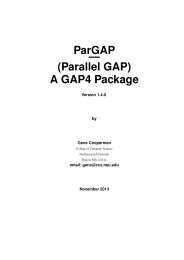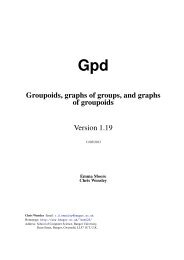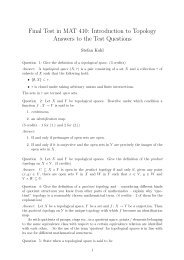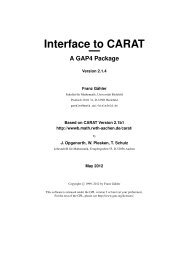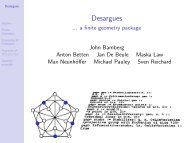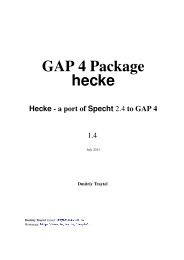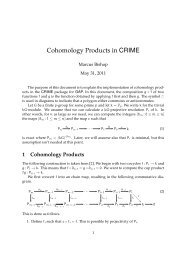guava - Gap
guava - Gap
guava - Gap
Create successful ePaper yourself
Turn your PDF publications into a flip-book with our unique Google optimized e-Paper software.
GUAVA 18<br />
In GUAVA, for linear codes, the map m ↦−→ c is computed using the command c:=m*C and recovering<br />
m from c is obtained by the command InformationWord(C,c). These commands are explained more<br />
below.<br />
Many operations are available on codewords themselves, although codewords also work together<br />
with codes (see chapter 4 on Codes).<br />
The first section describes how codewords are constructed (see Codeword (3.1.1) and IsCodeword<br />
(3.1.3)). Sections 3.2 and 3.3 describe the arithmetic operations applicable to codewords. Section<br />
3.4 describe functions that convert codewords back to vectors or polynomials (see VectorCodeword<br />
(3.4.1) and PolyCodeword (3.4.2)). Section 3.5 describe functions that change the way a codeword<br />
is displayed (see TreatAsVector (3.5.1) and TreatAsPoly (3.5.2)). Finally, Section 3.6 describes a<br />
function to generate a null word (see NullWord (3.6.1)) and some functions for extracting properties<br />
of codewords (see DistanceCodeword (3.6.2), Support (3.6.3) and WeightCodeword (3.6.4)).<br />
3.1 Construction of Codewords<br />
3.1.1 Codeword<br />
♦ Codeword(obj[, n][, F])<br />
(function)<br />
Codeword returns a codeword or a list of codewords constructed from obj. The object obj can<br />
be a vector, a string, a polynomial or a codeword. It may also be a list of those (even a mixed list).<br />
If a number n is specified, all constructed codewords have length n. This is the only way to make<br />
sure that all elements of obj are converted to codewords of the same length. Elements of obj that are<br />
longer than n are reduced in length by cutting of the last positions. Elements of obj that are shorter<br />
than n are lengthened by adding zeros at the end. If no n is specified, each constructed codeword is<br />
handled individually.<br />
If a Galois field F is specified, all codewords are constructed over this field. This is the only way<br />
to make sure that all elements of obj are converted to the same field F (otherwise they are converted<br />
one by one). Note that all elements of obj must have elements over F or over ‘Integers’. Converting<br />
from one Galois field to another is not allowed. If no F is specified, vectors or strings with integer<br />
elements will be converted to the smallest Galois field possible.<br />
Note that a significant speed increase is achieved if F is specified, even when all elements of obj<br />
already have elements over F.<br />
Every vector in obj can be a finite field vector over F or a vector over ‘Integers’. In the last case,<br />
it is converted to F or, if omitted, to the smallest Galois field possible.<br />
Every string in obj must be a string of numbers, without spaces, commas or any other characters.<br />
These numbers must be from 0 to 9. The string is converted to a codeword over F or, if F is omitted,<br />
over the smallest Galois field possible. Note that since all numbers in the string are interpreted as onedigit<br />
numbers, Galois fields of size larger than 10 are not properly represented when using strings. In<br />
fact, no finite field of size larger than 11 arises in this fashion at all.<br />
Every polynomial in obj is converted to a codeword of length n or, if omitted, of a length dictated<br />
by the degree of the polynomial. If F is specified, a polynomial in obj must be over F.<br />
Every element of obj that is already a codeword is changed to a codeword of length n. If no n<br />
was specified, the codeword doesn’t change. If F is specified, the codeword must have base field F.<br />
Example<br />
gap> c := Codeword([0,1,1,1,0]);<br />
[ 0 1 1 1 0 ]






